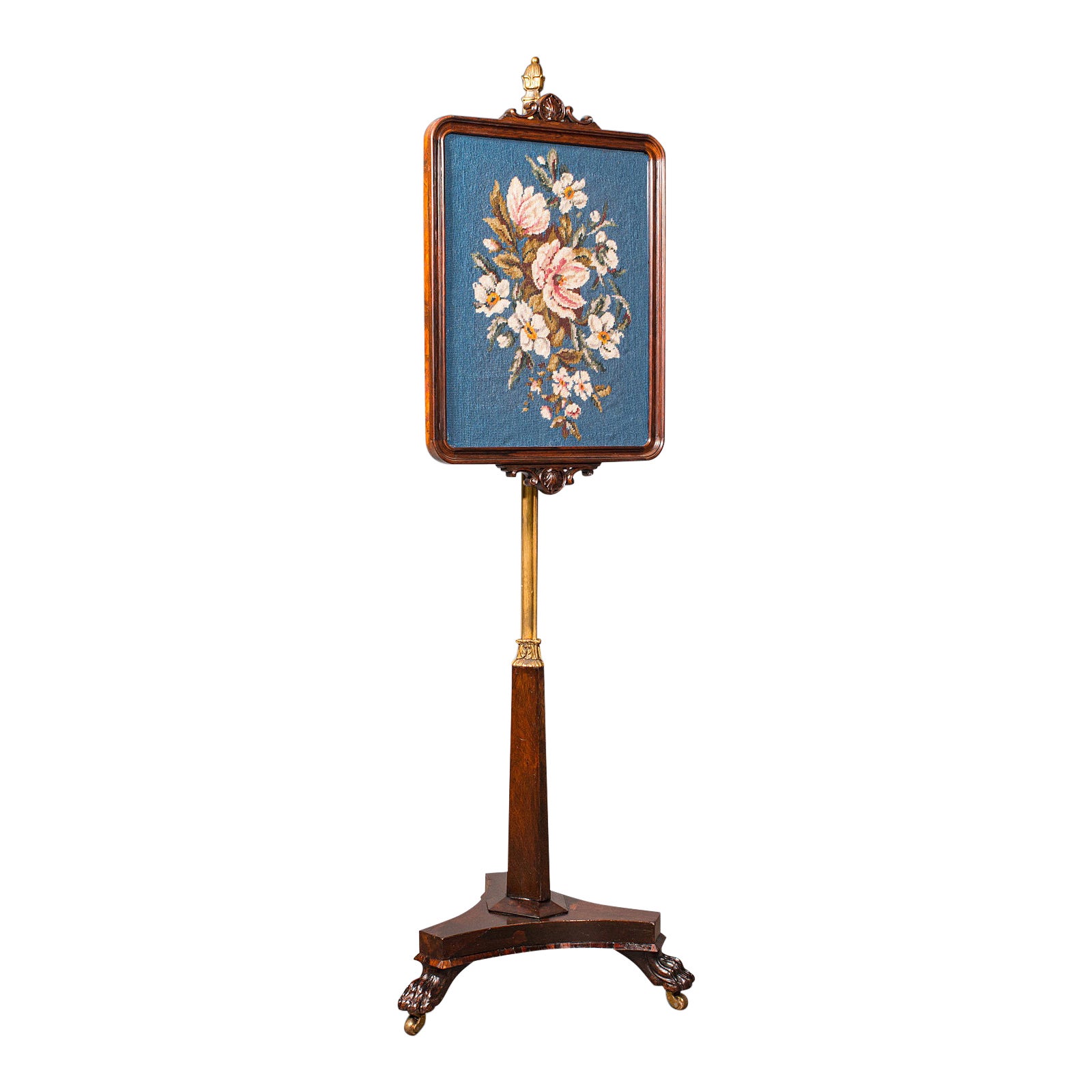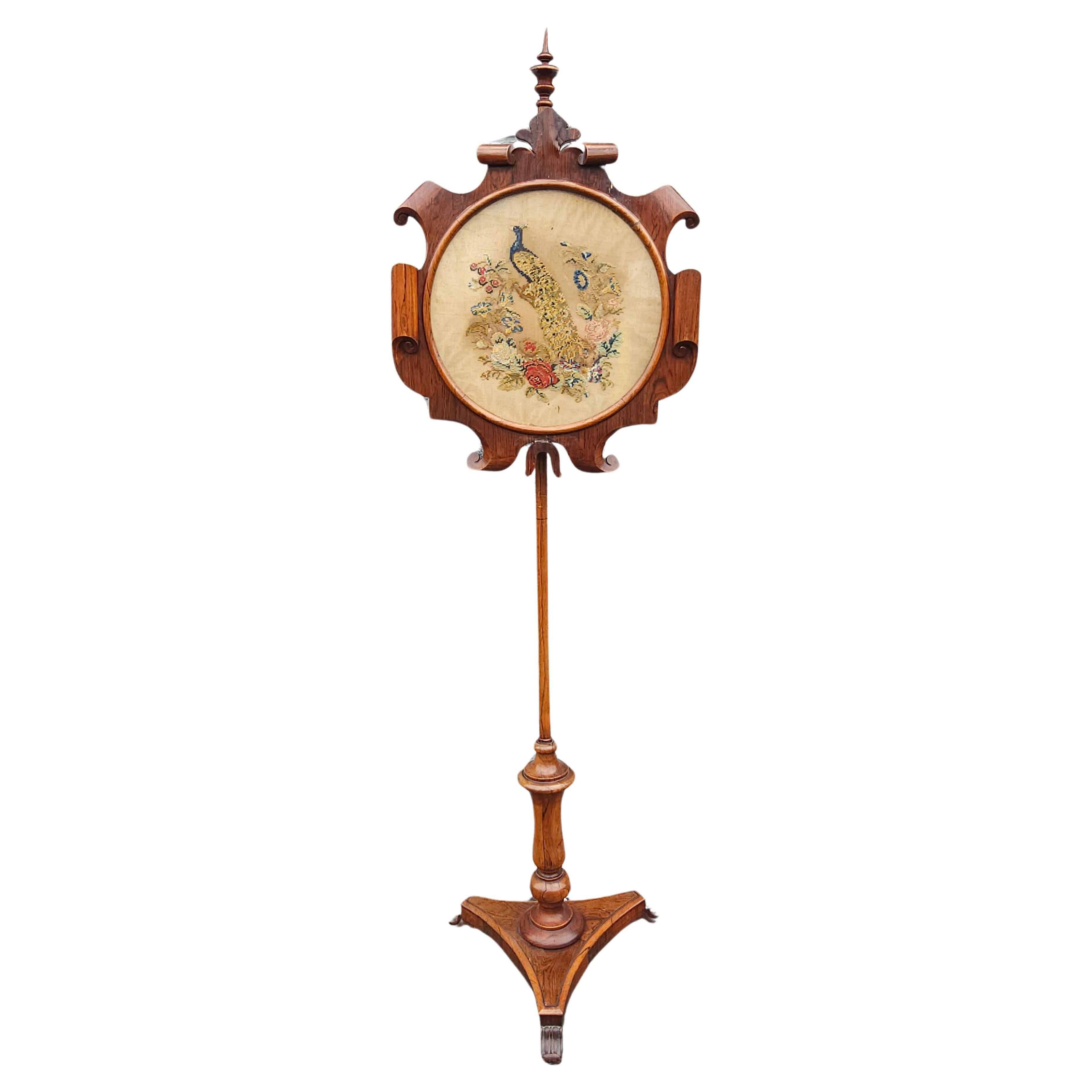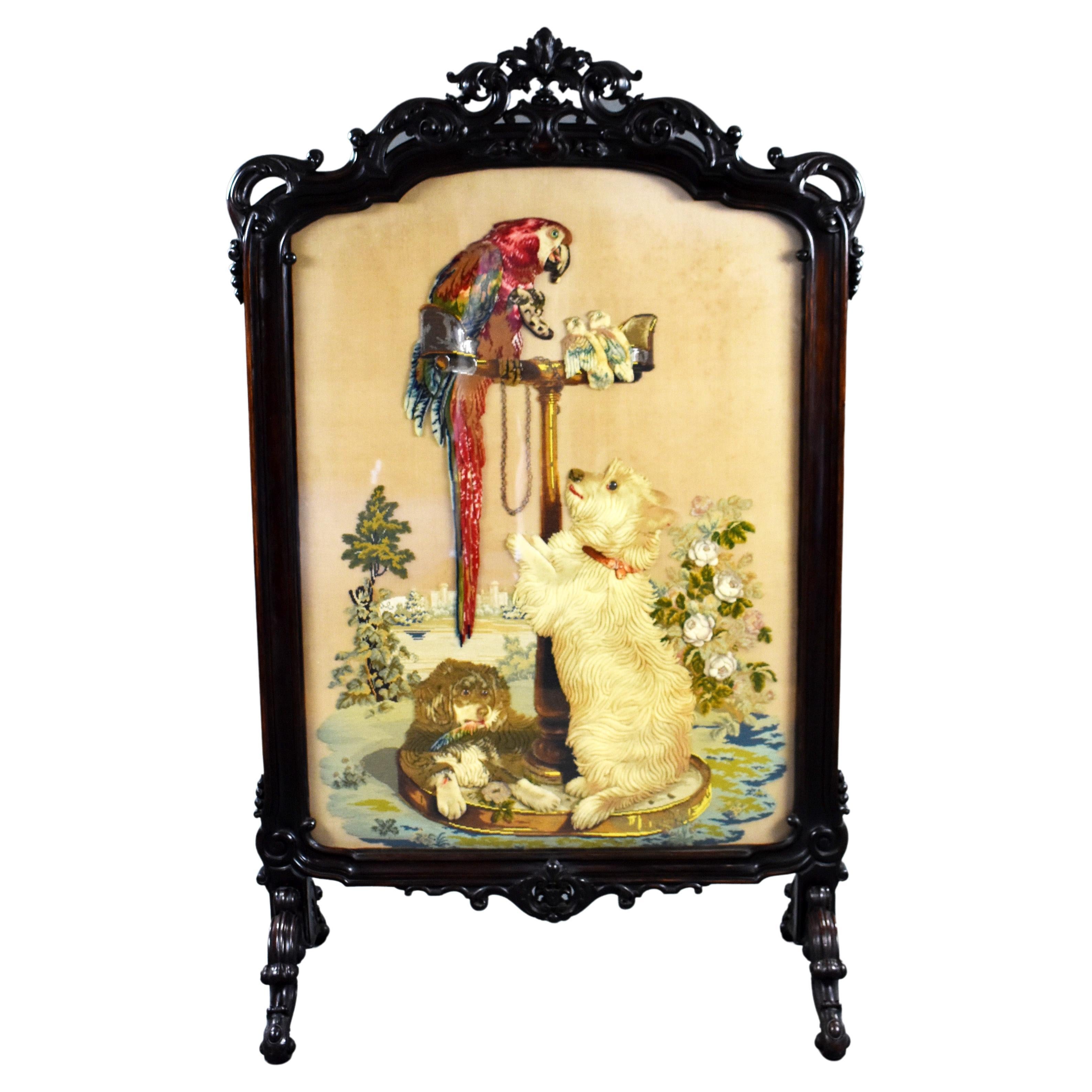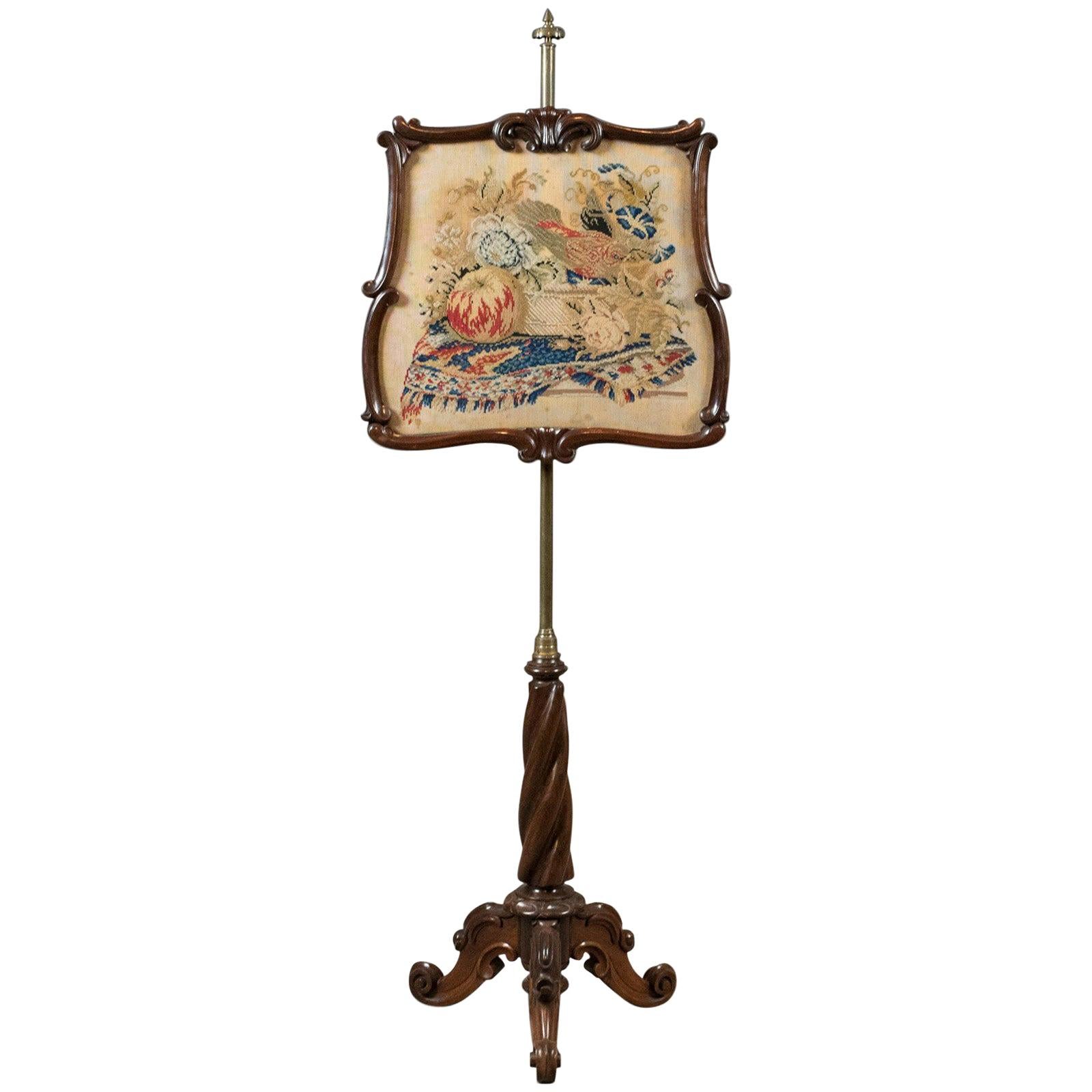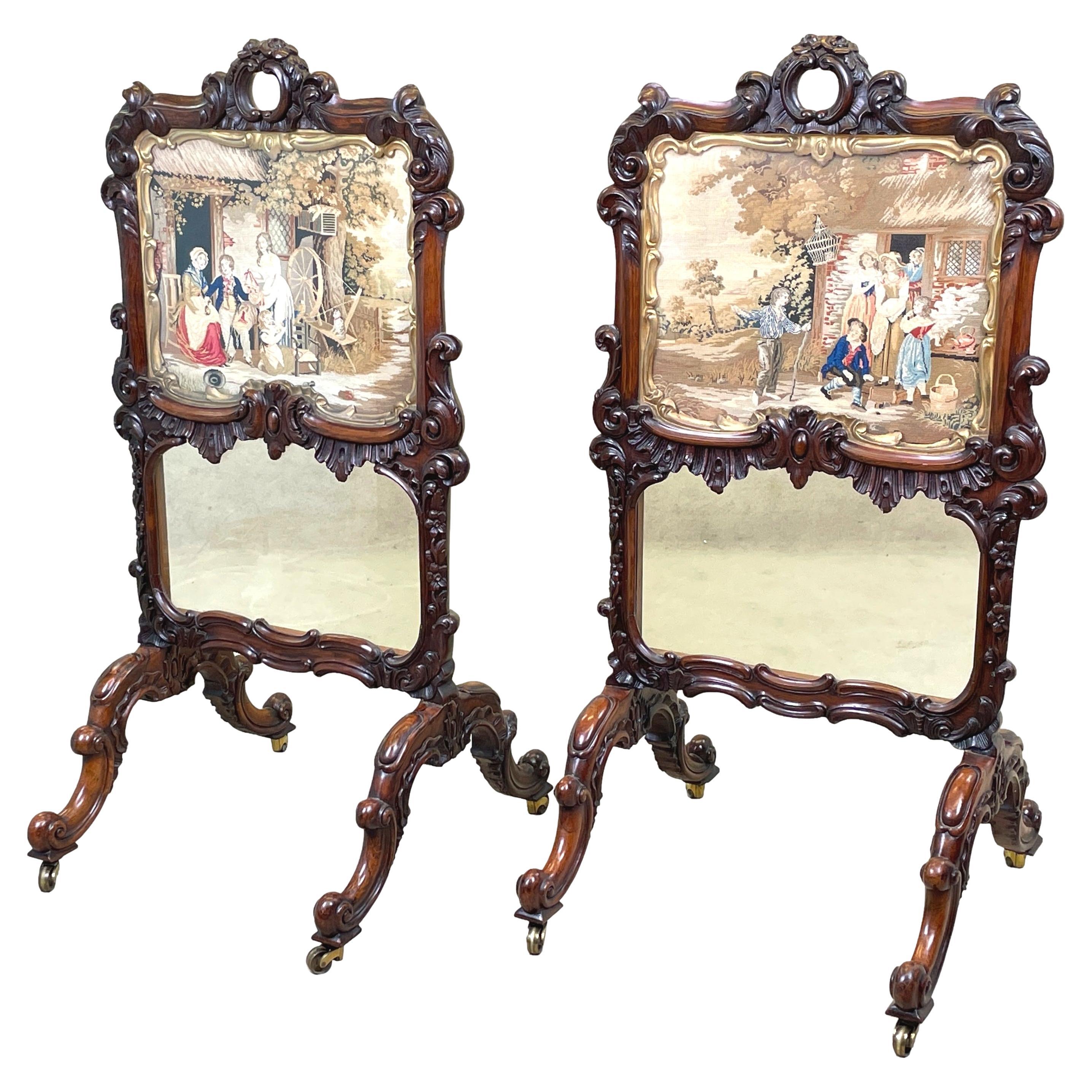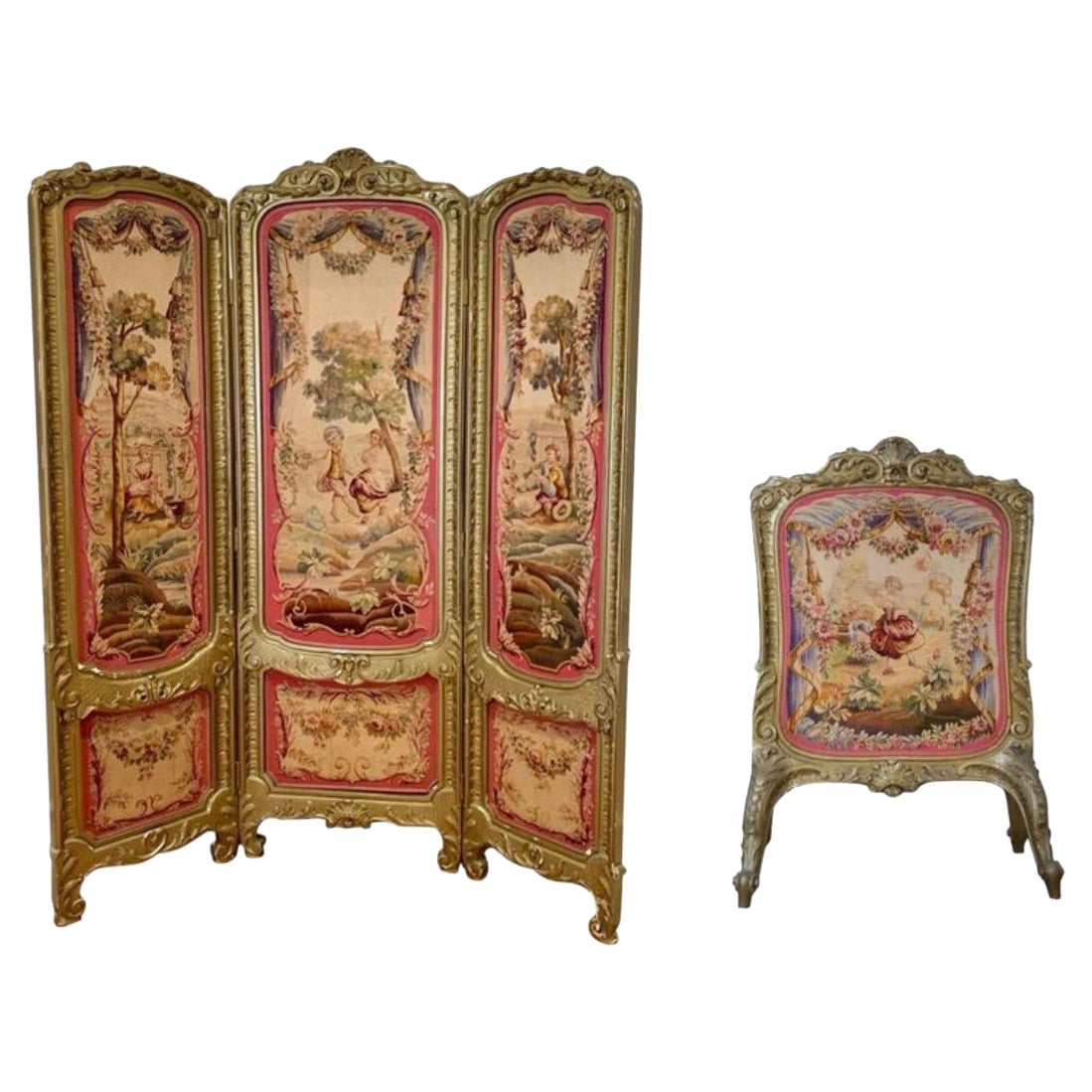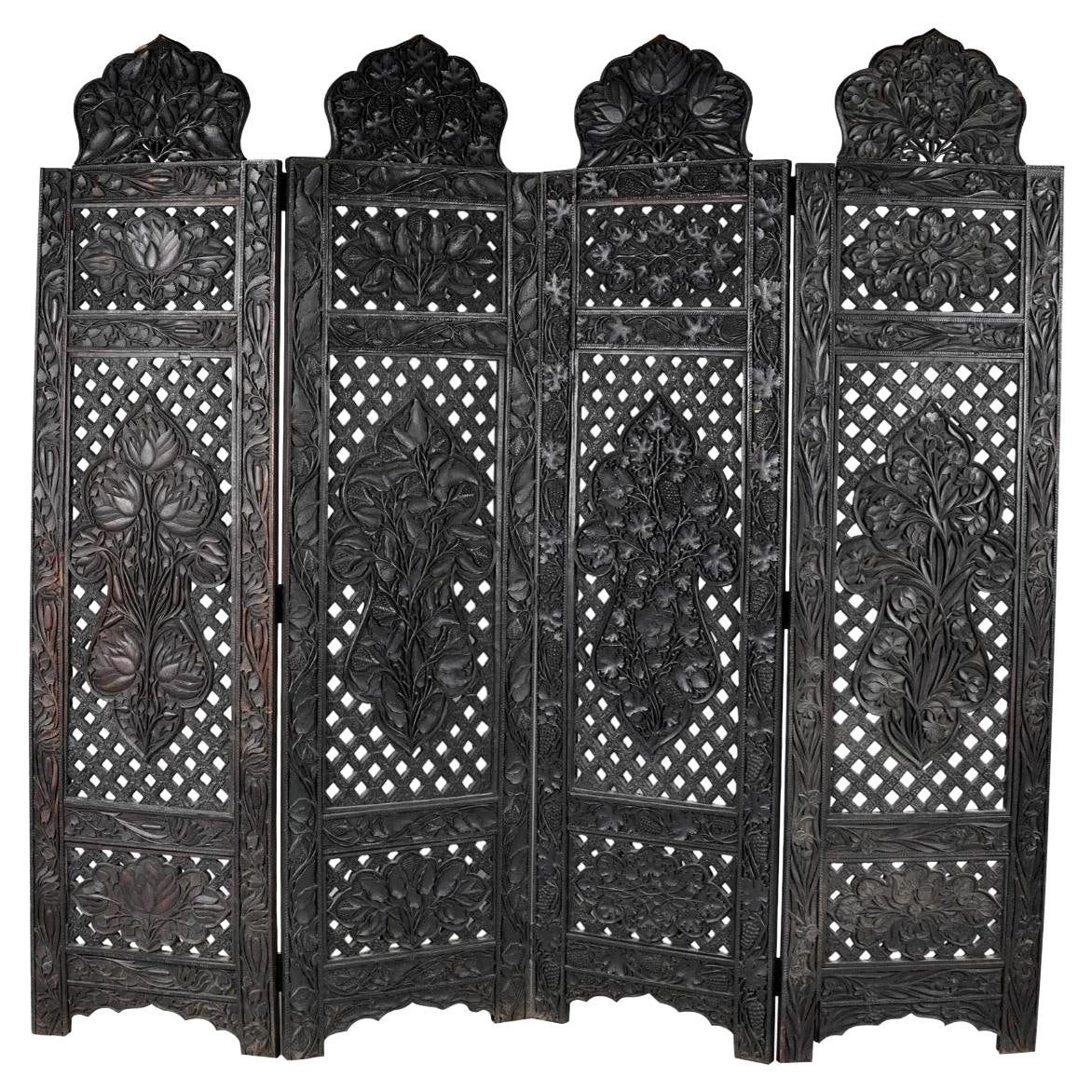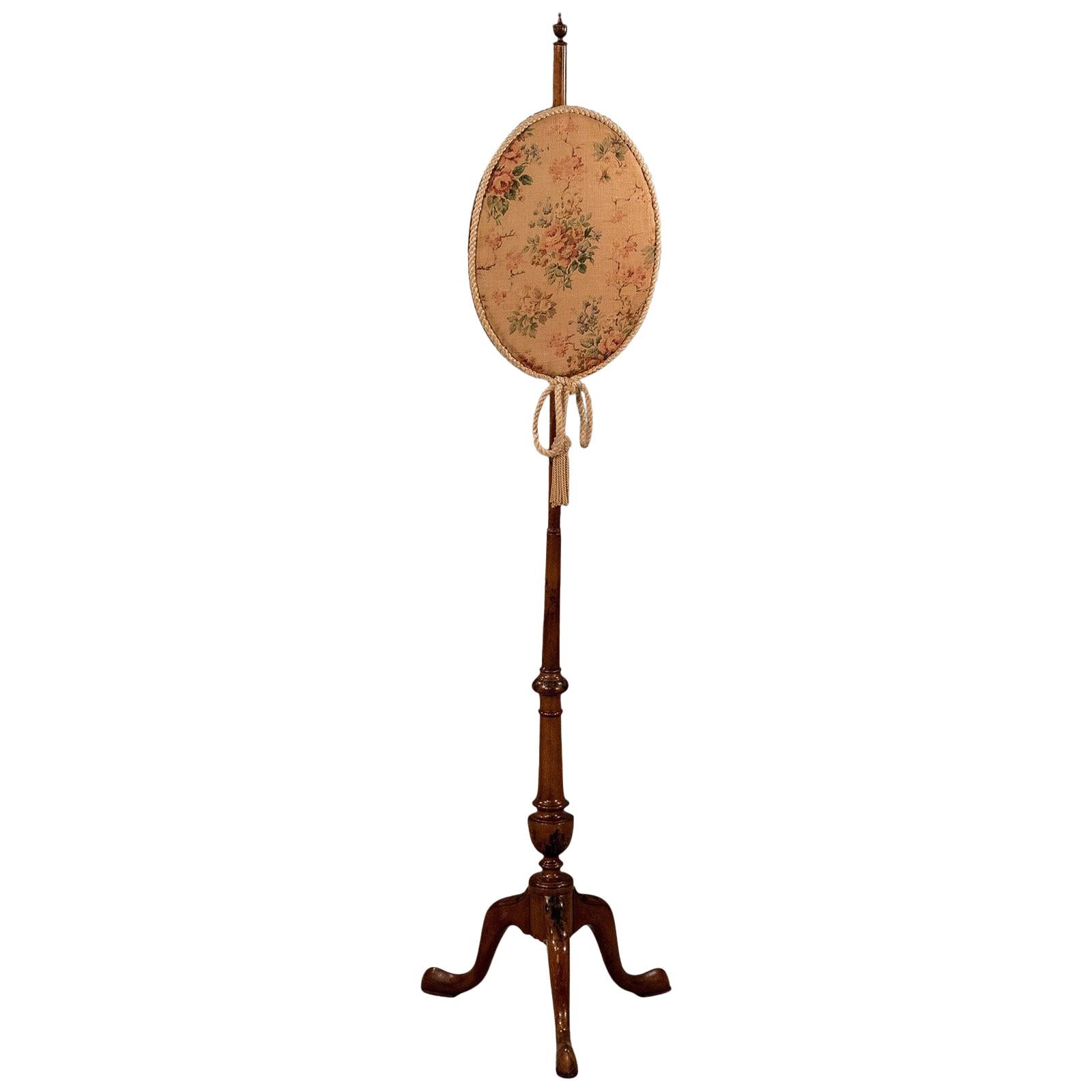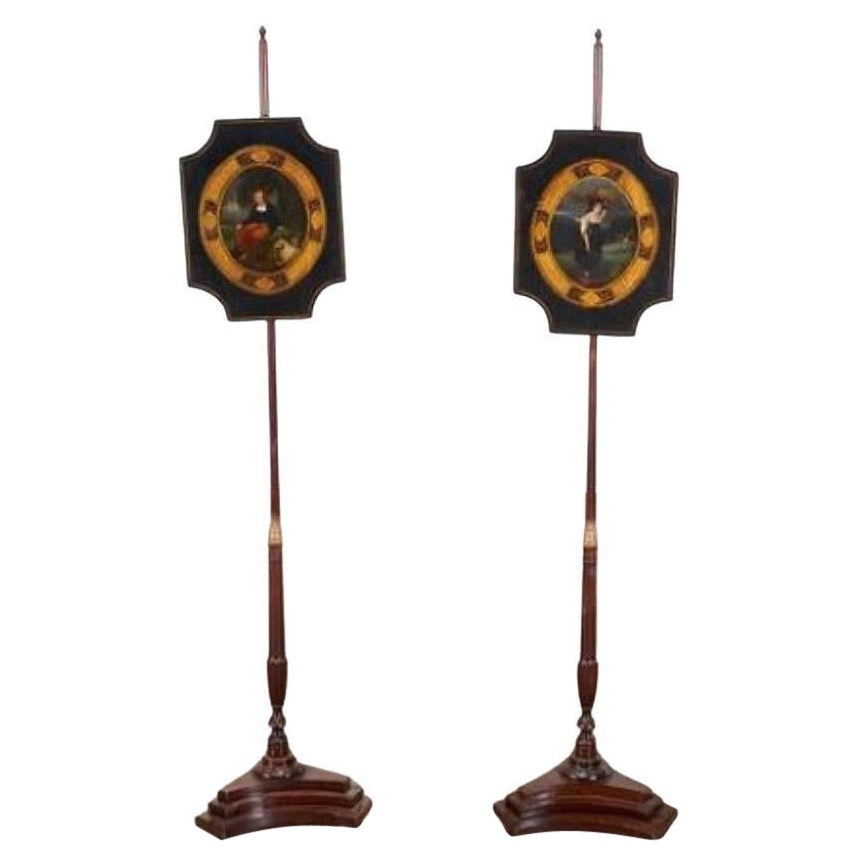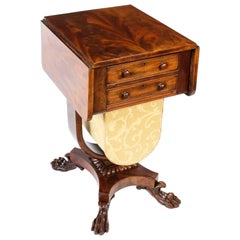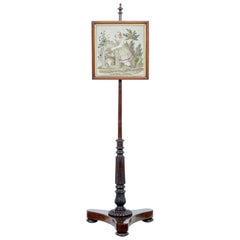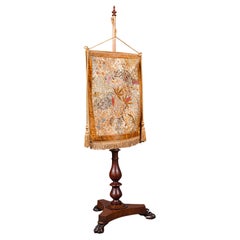
19th Century William IV Rosewood Tapestry Pole Screen
View Similar Items
Want more images or videos?
Request additional images or videos from the seller
1 of 11
19th Century William IV Rosewood Tapestry Pole Screen
About the Item
- Dimensions:Height: 60.24 in (153 cm)Width: 17.72 in (45 cm)Depth: 17.72 in (45 cm)
- Style:William IV (Of the Period)
- Materials and Techniques:
- Place of Origin:
- Period:
- Date of Manufacture:circa 1935
- Condition:
- Seller Location:London, GB
- Reference Number:Seller: 065271stDibs: LU95068240093
About the Seller
5.0
Platinum Seller
These expertly vetted sellers are 1stDibs' most experienced sellers and are rated highest by our customers.
Established in 1983
1stDibs seller since 2012
1,203 sales on 1stDibs
Associations
LAPADA - The Association of Arts & Antiques Dealers
More From This SellerView All
- Antique French Giltwood Dressing Screen with Oil Painting Portrait, 19th CenturyLocated in London, GBA fine beautiful antique French Louis Revival giltwood three panel dressing screen with portrait, circa 1850 in date. The screen features three beautifully carved beaded egg...Category
Antique 1850s French Screens and Room Dividers
MaterialsGiltwood
- Antique William IV Gilt Bronze Table Lamp, 19th CenturyLocated in London, GBA large, 72cm, beautiful English William IV table lamp, circa 1835 in date. The striking lamp features the original glass receiver, classic William IV design and has been converte...Category
Antique 1830s English William IV Table Lamps
MaterialsBronze
- Antique William IV Drop-Leaf Work Occasional Table Flame Mahogany, 19th CenturyLocated in London, GBAn exquisite antique William IV flame mahogany drop leaf work table, circa 1830 in date. The drop-leaf top with rounded corners supported by fly brackets ornamented with foliate scr...Category
Antique 1830s English William IV Tables
MaterialsMahogany
- Antique Victorian Betjemann's Porcelain Coromandel Book Slide, 19th CenturyBy Betjemanns & SonsLocated in London, GBThis is a high quality antique Victorian coromandel porcelain inset adjustable book slide, by Betjemann's, 19th century and circa 1870 in date. It is made of stunnning coromandel...Category
Antique 1870s English Victorian Bookends
MaterialsBrass
- Antique Large William IV Silver Tray Salver by Paul Storr 1837 19th CenturyBy Paul StorrLocated in London, GBThis is a wonderful English antique William IV sterling silver tray, or salver, by the world famous silversmith Paul Storr. It has clear hallmarks for London 1837 the makers mark of Paul Storr and is also engraved Storr & Mortimer 36, they were Goldsmiths and Jewellers to Her Majesty’ (1822-1839). It is typical of his work with the octafoil shape and the exquisitely detailed foliate and acorn rim. It is raised on four delightful foliate and scroll feet. The centre is engraved with a shield shaped coat of arms encompassing the lion rampant which I have had researched: The Arms of the Family of King The arms as engraved upon this William IV English Sterling Silver Footed Salver by Paul Storr hallmarked London 1837 are those of the family of King. They may be blazoned as follows: Arms: Sable a lion rampant between three crosses formy fitchy argent Undoubtedly this salver was in the possession of a gentleman who was member of a family bearing the name of King. There are a number of variants of these armorial bearings being borne by King families. Very often the lion is of a different tincture but the field of the shield is invariably remains ‘sable’. Similar arms and crest were recorded by Sir Edward Bysshe, Clarenceux King of Arms in his Visitation of the County of Kent of 1663 to the family of King, of Bromley. The tinctures of both arms and crest of King, of Bromley were slightly different to those engraved upon this tureen in that the Visitation family’s arms were ‘Sable a lion rampant ermine between three crosses paty fitchy or’ 1 and the crest ‘A lion’s gamb erect and erased sable holding a cross paty fitchy or’(see illustration below). These arms and crest were granted by Sir Edward Walker, Garter King of Arms on the 20th February 1660 – 61; and yet another Kentish family of King, of Bellevue who were created Baronets within the Baronetage of Great Britain in 1792 bore for their arms ‘Sable a lion rampant erminois between three crosses paty fitchy or’. Their crest being the same as the family of King, of Bromley. There is no mistaking its unique quality and design, which is sure to make it a treasured piece by any discerning collector. Please see potos of the 2nd Baronet Timothy Shelley, 1753-1844 and Castle Goring, his home. Condition: In excellent condition with clear hallmarks and no dings, dents or signs of repair. Please see photos for confirmation. Dimensions in cm: height 4 x width 44 x depth 44 Weight 1.96 kg Dimensions in inches: height 2 inches x width 1 foot, 5 inches x depth 1 foot, 5 inches Weight 63 troy oz Paul Storr born in London England in 1771, was to become one of the most talented silversmiths of the nineteenth century. Today his legacy of exceptionally well crafted silver, found worldwide in museums and private collections, leaves one in awe when compared to that of his contemporaries.After having served a seven year apprenticeship from the age of 14, he began his career in 1792 when he went into a brief partnership with William Frisbee. This did not last and in 1793 a new mark, (his initials ‘P S’) was entered. By the beginning of the nineteenth century he had established himself as one of London’s top silversmiths producing, amongst others, commissions for Royalty. In 1801 he married Elizabeth Susanna Beyer with whom he was to have ten children. In 1807 Paul Storr entered into a working relationship with Philip Rundell and by 1811 was a partner, and managing the workshops for Rundell, Bridge & Rundell. During this period he kept his own marks and separate workshop. However it was through Rundell, Bridge & Rundell who were appointed Goldsmith in Ordinary to George III in 1804 that his reputation as a master silversmith grew. His talents lay in being able to transform ideas and designs from Rundell, Bridge & Rundell’s designers, William Theed...Category
Antique 1830s English William IV Sterling Silver
MaterialsSterling Silver
- Antique Large William IV Silver Tray Salver by Paul Storr 1820 19th CenturyBy Paul StorrLocated in London, GBThis is a wonderful English antique William IV sterling silver tray, or salver, by the world famous silversmith Paul Storr. It has clear hallmarks for London 1820 the makers mark of Paul Storr. It is typical of his work with the octafoil shape and the exquisitely detailed reeded rim, and it is raised on four delightful foliate and scroll feet. The centre is engraved with a shield shaped coat of arms which I have had researched. The Marital Arms of Knollis and Hallifax The armorial bearings as engraved upon this George IV Large English Sterling Silver Footed Salver by Paul Storr hallmarked London 1820 are those of the family of Knollis with Hallifax in pretence. These armorial bearings denote the marshalling of a marital coat showing the arms of the husband over the entire surface of the shield, whilst the arms of the wife (as an heraldic heiress) are placed on a small shield (known as an escutcheon of pretence) centrally on the husband’s arms. They may be blazoned as follows: Arms: Quarterly 1st and 4th Azure crusily of cross crosslets a cross moline voided or (for Knollys) 2nd and 3rd Gules on a chevron argent three roses of the field barbed proper (for Knollys) over all an escutcheon of pretence Or on a pile engrailed sable between two fountains barry wavy of six argent and azure three cross crosslets of the first (for Hallifax) Crest: An elephant argent [differenced with a mullet1 ] (for Knollys) Motto: In utrumque paratus [Prepared for either] (for Knollys) These armorial bearings undoubtedly commemorate the marriage of The Honourable and Reverend Francis Knollis2 (baptised 3rd January 1743 died 27th February 1826), 1 The cadency mark for a third son of a family. 2 Francis appears to have preferred this spelling of his family’s surname. It is spelt as it is to be pronounced. of Burford in the County of Oxfordshire and of Eastleach Martin in the County of Gloucestershire and Mary Hallifax (baptised 5th March 1753 buried 18th December 1830). Francis and Mary were married at the Parish Church of St Mary, Ewell in the County of Surrey on the 9th June 1772. Francis was the third son of Charles Knollys (the titular 5th Earl of Banbury) 3 and his wife, Martha Hughes, whilst Mary was the daughter of The Reverend James Hallifax, of Ewell aforesaid and his wife, Elizabeth Chardavoyn. 3 Francis’s father claimed to be the 5th Earl of Banbury. A claim that continued to be pursued by the family until William Knollys, the titular 8th Earl of Banbury (born 1763 died 1834) was forced to discontinue its use by a resolution of the House of Lords which rejected his claim to the earldom in 1813. The crest surmounts a detailed dedication: This piece of plate was presented to the Honourable Rev Knolls by the inhabitants of the town and immediate neighbourhood of Burford on his completing the fiftieth year of his incumbency as the vicar of Burford. In testimony of their high respect 11th April 1821 There is no mistaking its unique quality and design, which is sure to make it a treasured piece by any discerning collector. Condition: In excellent condition with clear hallmarks and no dings, dents or signs of repair. Please see photos for confirmation. Dimensions in cm: Height 3 x Width 36 x Depth 36 Weight 1.52 kg Dimensions in inches: Height 1 inch x Width 1 foot, 2 inches x Depth 1 foot, 2 inches Weight 49 troy oz Paul Storr born in London England in 1771, was to become one of the most talented silversmiths of the nineteenth century. Today his legacy of exceptionally well crafted silver, found worldwide in museums and private collections, leaves one in awe when compared to that of his contemporaries.After having served a seven year apprenticeship from the age of 14, he began his career in 1792 when he went into a brief partnership with William Frisbee. This did not last and in 1793 a new mark, (his initials ‘P S’) was entered. By the beginning of the nineteenth century he had established himself as one of London’s top silversmiths producing, amongst others, commissions for Royalty. In 1801 he married Elizabeth Susanna Beyer with whom he was to have ten children. In 1807 Paul Storr entered into a working relationship with Philip Rundell and by 1811 was a partner, and managing the workshops for Rundell, Bridge & Rundell. During this period he kept his own marks and separate workshop. However it was through Rundell, Bridge & Rundell who were appointed Goldsmith in Ordinary to George III in 1804 that his reputation as a master silversmith grew. His talents lay in being able to transform ideas and designs from Rundell, Bridge & Rundell’s designers, William Theed...Category
Antique 1820s English William IV Sterling Silver
MaterialsSterling Silver
You May Also Like
- 19th century William IV mahogany pole screenLocated in Debenham, Suffolk19th century William IV mahogany pole screen, circa 1830 Framed original tapestry depicting a young lady outside with a dog. Frame with gilt slip. Supported by a turned and carved s...Category
Antique Mid-19th Century English William IV Screens and Room Dividers
MaterialsMahogany
- Antique Fireside Pole Screen, English, Rosewood, Needlepoint, William IV, C.1830Located in Hele, Devon, GBThis is an antique fireside pole screen. An English, Rosewood and ormolu adjustable fire screen with needlepoint panel, dating to the William IV period, circa 1830. Attractive adj...Category
Antique Early 19th Century British Screens and Room Dividers
MaterialsRosewood
- Antique Pendant Pole Screen, English, Fireside Tapestry Stand, William IV, 1835Located in Hele, Devon, GBThis is an antique pendant pole screen. An English, mahogany and silk cotton fireside tapestry stand, dating to the William IV period, circa 1835. Striking example of fireside dis...Category
Antique Early 19th Century British Screens and Room Dividers
MaterialsWood
- 19th C Victorian Renaissance Rosewood Floral And Peacock Needlepoint Pole ScreenLocated in Germantown, MDA 19th Century Victorian Renaissance style Rosewood with Floral And Peacock Needlepoint Pole Screen with exceptional craftsmanship. Adjustable height screen. Screen protected by an a...Category
Antique Mid-19th Century American Victorian Screens and Room Dividers
MaterialsTapestry, Rosewood
- 19th Century English Victorian Rosewood Fire ScreenLocated in Chelmsford, EssexFor sale is a fine and rare large Victorian rosewood screen, having an ornately carved top, above embroidery, depicting a dog jumping up at a parrot on a perch, with two other small birds on the perch beside it another dog lies on the base of the perch, on the left, holding a feather in its mouth, its paw on a sealed letter after Landseer. 1851. The parrots stand...Category
Antique Mid-19th Century English Victorian Screens and Room Dividers
MaterialsRosewood
- Pair of Early 19th Century English Regency Black Lacquered Pole ScreensLocated in Atlanta, GAPair of Early 19th Century English Regency Black Lacquered Pole Screens with Silk Embroidered TextilesCategory
Antique Early 19th Century English Regency Screens and Room Dividers
MaterialsMetal

